Service Tabs
Each of the different Service types (Phone, Data, Auth Code, etc) share a common set of tabs used to track associated data. To access Services, navigate to Main > Services.
Charges
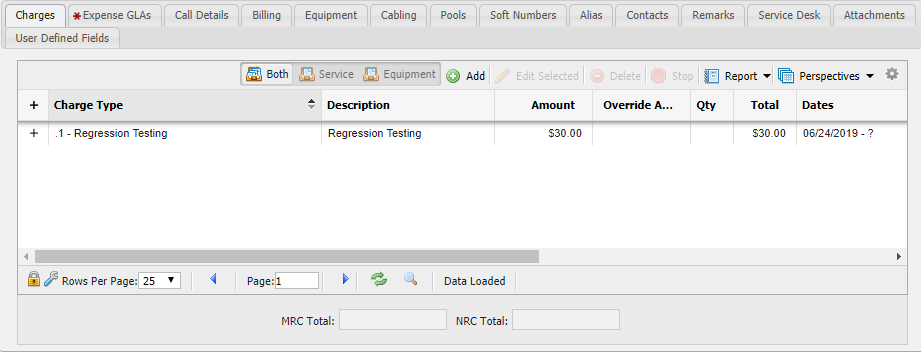
Charges Tab example
The Charges tab provides the User access to manually control how each Service is billed. There are four functions that can be used to control these Charges: Add, Edit, Delete, and Stop. If you do not want users to modify Charges outside of Service Desk, the configuration option MODIFY_CHARGES_WITHOUT_SERVICE_DESK to modify "permissions" on how Charges can be managed.
MODIFY_CHARGES_WITHOUT_SERVICE_DESK defaults to ADMINISTRATIVE_USERS. What this means is that non-Admin Users can only Stop and Start Charges through a Service Desk Item, usually a Service Desk Action. If this configuration is changed to ALL_USERS by PCR at the Customer’s request, then any User with access to that form can Stop and Start charges directly on the service. This is often desirable for quick “record-keeping” type updates. At this point, the Admins can still remove access to the Add, Delete, and Stop buttons via system security if desired.
If there are Charges on the Service, with incomplete Billing, the Billable flag should be checked. For more details, please see the Fields, Logic, and Rules article for Services.
Add
After clicking the ![]() button, the Add New Service Charges form opens.
button, the Add New Service Charges form opens.
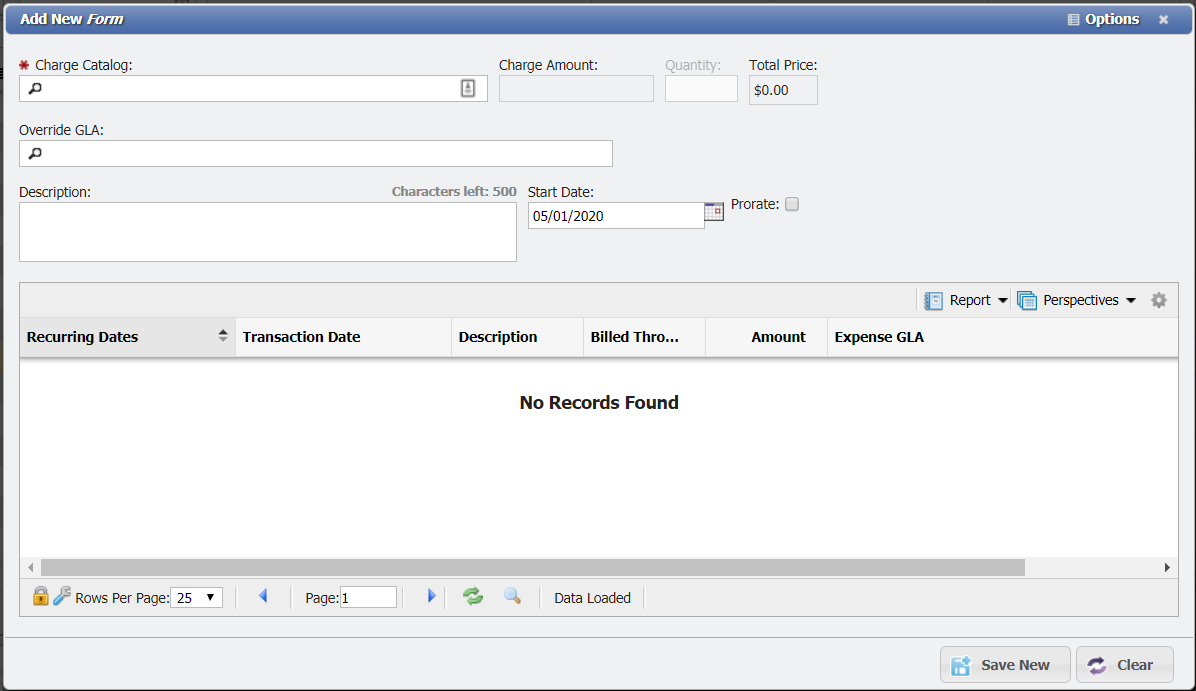
The Add New Service Charges form
From here, the User can select the Charge Catalog and an Override GLA if so desired. The Charge Amount auto fills based on the Default Amount from the given Charge Catalog. Sometimes there is an option for a Charge Override Amount based on the Charge Catalog. A Description is highly recommended for tracking purposes. The Description will be used on the View Bill report for each given Charge. The User can select to prorate the Charges or not based on Billing needs.
Future Start Dates
When a Start Date is set to be in the future on a new Charge, the Charge will not take effect until that Date. Service Desk Actions will ignore any future Charges; Charges will take effect on the Finalization Date.
Editing
The ![]() button can only be used after a Charge has been added. This form allows the User to select from the Charge Catalog and specify overrides when available to the Charge Override Amount, Quantity, Description, and Override GLA. Once saved, the Charge generates the records required for Billing.
button can only be used after a Charge has been added. This form allows the User to select from the Charge Catalog and specify overrides when available to the Charge Override Amount, Quantity, Description, and Override GLA. Once saved, the Charge generates the records required for Billing.
Note: Charges cannot be added to Services that are not flagged as Billable.
Note: A Default Expense GLA must be supplied on the Expense GLAs tab before Charges can be added.
When a Charge is edited, the User is prompted to select when that change should apply. Selecting "Effective Today" will apply the change immediately, while selecting "Date to Last Billed" will begin as of the date of the last Bill Run. An example of the prompt is displayed below.

Effective Date prompt dialogue example
Deleting/Stopping
It is sometimes necessary to manually delete or stop a Charge. There are certain restrictions in place to prevent deleting Charges that have been billed. After clicking the ![]() button, a prompt is displayed, warning the User that Non Recurring Charges that have already been Billed will not be deleted and that Monthly Recurring Charges that have already been Billed will be stopped if they would like to continue with the action.
button, a prompt is displayed, warning the User that Non Recurring Charges that have already been Billed will not be deleted and that Monthly Recurring Charges that have already been Billed will be stopped if they would like to continue with the action.

Confirm Delete Dialogue Example
When stopping a Charge, click the ![]() button. A prompt is displayed requesting a Stop date and advising the User about further restrictions for on stopping Charges, such as Billed Non-Recurring Charges not being deleted, Monthly Recurring Charges being stopped on the Stop Date, and Alternate Recurring Charges (Annual, Semi-Annual and Quarterly) also being stopped.
button. A prompt is displayed requesting a Stop date and advising the User about further restrictions for on stopping Charges, such as Billed Non-Recurring Charges not being deleted, Monthly Recurring Charges being stopped on the Stop Date, and Alternate Recurring Charges (Annual, Semi-Annual and Quarterly) also being stopped.
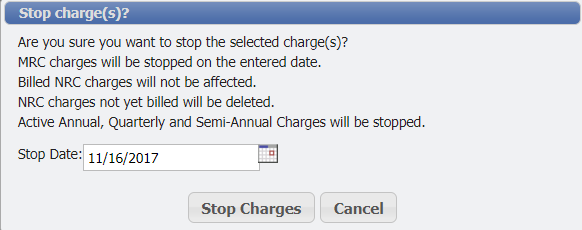
Stop Charges Dialogue example
Applying an Alternate Recurring Charge
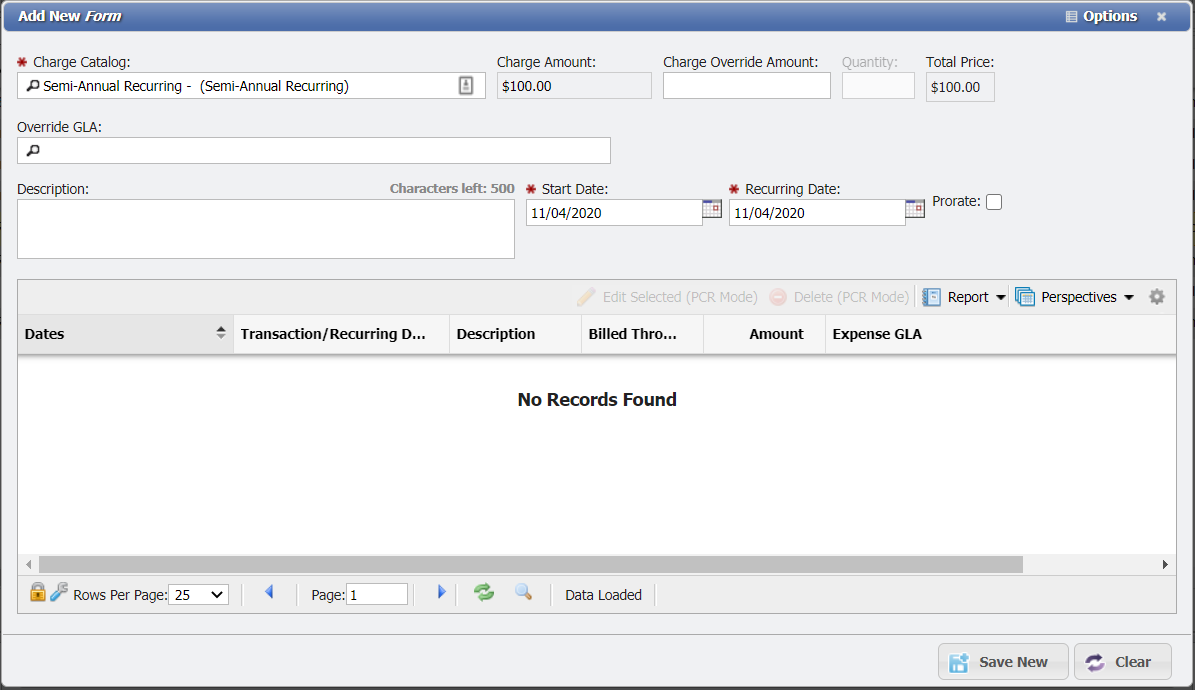
Alternate Recurring Charge Example
When an Alternate Recurring Charge is selected as the Charge Catalog (Quarterly, Semi-Annual and Annual Charges) for a new Charge, the form gains the addition of a Recurring Date field. This is the date that will be used by the Billing Process to determine which Bills the Charge should display on. The Recurring Date can not occur after the Start Date.
Expense GLAs
This tab is of particular importance to the User organization's financial team in that it allows Users to set GLAs for new Services and edit those of existing Services.
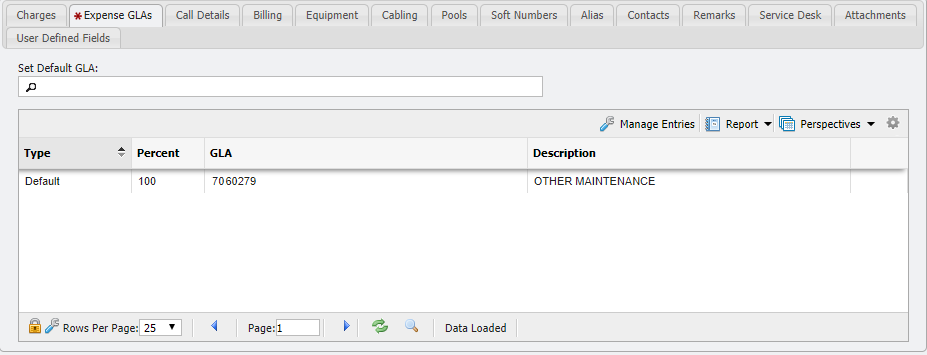
Expense GLA Tab example
To set a Default GLA for Service, click the Picker Icon (

Managing GLA Entries
Users can specify GLAs by clicking the

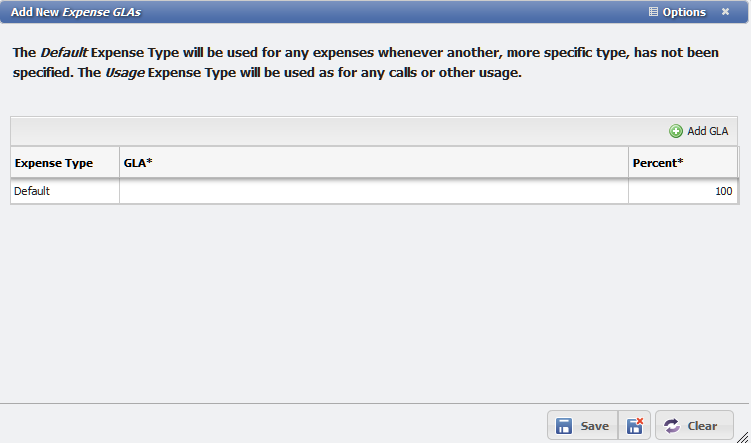
Add New Expense GLA form example
From this form, the User can set a single GLA or Multiple GLAs quickly and without having to re-open the form multiple times. There are three fields that can be edited on the table whether the User is Adding a Single GLA or Multiple GLAs.
Expense Type - This drop-down allows the User to select the Expense Type of the GLA.

Expense Type field example
GLA - This picker allows the User to select the GLA to associate with the Expense Type.

GLA Picker field example
Percent - The number selector allows the User to specify the percent of the Expense Type to apply to the GLA.

Percent field example
Single GLA
The first row of the table is added by default. The User only needs to select the 'Expense Type', 'GLA', and 'Percent' and click the

Multiple GLAs
To add multiple GLAs the User can follow these steps:
Click the
 button.
button.This adds a row to the table.
Repeat to add as many rows as are required.
When adding multiple GLAs, the percentages of a given 'Expense Type' must equal 100% as in the following example:
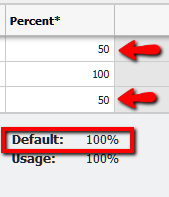
Manage GLA Percentages, sum to 100 example
If the Percentages are not enough to equal 100%, or exceed 100% the User receives a notice as in the following example:

Manage GLA, sum to over 100 example
Once the User has added all the desired GLAs, the form can be saved by clicking the
 button. The GLAs are added to the Grid on the Expense GLA tab.
button. The GLAs are added to the Grid on the Expense GLA tab.
To delete a single GLA record the User must follow these steps:
From the Add New Expense GLA form, chose the row to delete.
In this example, the Equipment Expense Type is being deleted.

Manage GLA form example
Right-click the 'Equipment' row. This opens the table context menu.

Delete GLA Record example
Click the Delete Row menu option.
The row is deleted.
Click the
 button.
button.
The Grid updates and the GLA is removed.
Call Details
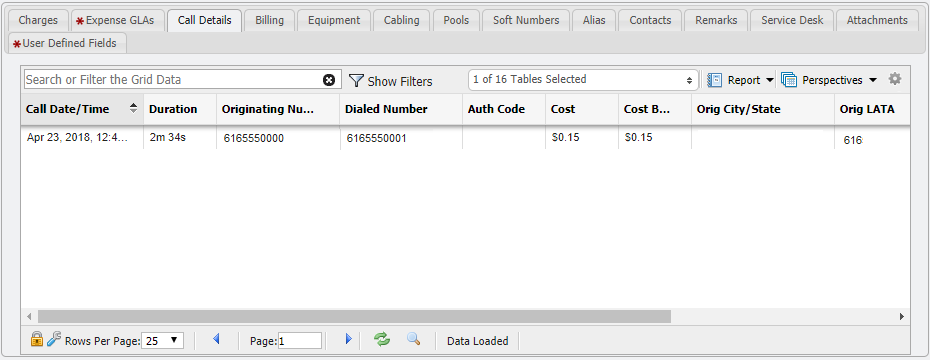
Call Details tab example
The Call Details tab provides a listing of all Rated Calls made by this Service. This tab is only available for Phone and Auth Code services. Here, Users can search through all Calls that have been recorded for the Service. This grid displays all Calls recorded with several different variations of the Service ID such as (616) 555-1028 or 555-1028 or 51028 or 1028. It searches for these variations in the Origination and destination phone files.
Billing
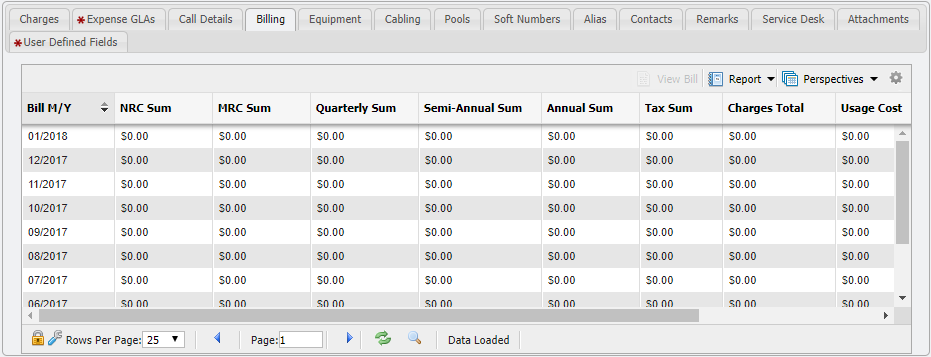
Billing Tab example
The Billing tab provides a listing of every Bill on which this Service has appeared and the MRC, NRC, and Usage Totals that were billed. All Bills that have been run for the specific Service can be viewed and reported on from this tab.
Equipment
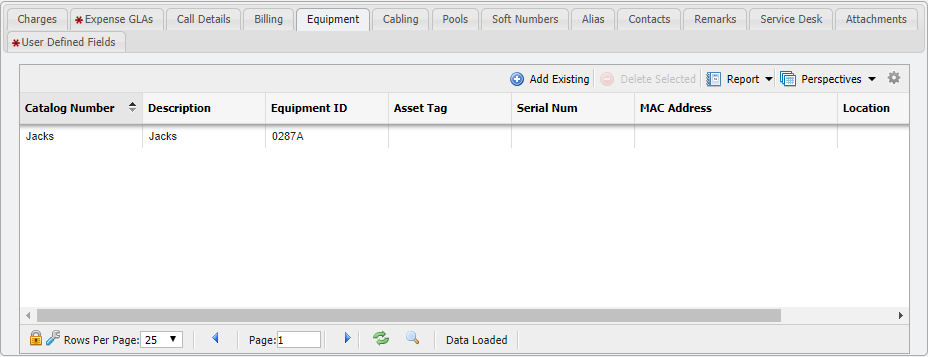
Equipment Tab example
The Equipment tab provides the User the ability to manually associate Equipment with a Service. For example, a specific Phone Service may have a phone set, headset, adapters, etc. associated with that Service. This Equipment can be inventoried separately but can be associated with this Service for tracking purposes. Equipment association does not force the data on the Equipment to match data on the Service however when this association is built with Service Order Equipment on Service Desk the information matches automatically.
The User can manually manage these associations by using either the


Adding Existing Equipment
After clicking the Add Existing button, a list of existing Equipment is presented. An Equipment inventory item must exist before it can be associated with a Service (see the Inventory section for Creating a New Piece of Equipment ). Additionally, Equipment can only be associated with one Service at a time. Consequently, this list only contains Equipment that is not already associated with another Service.
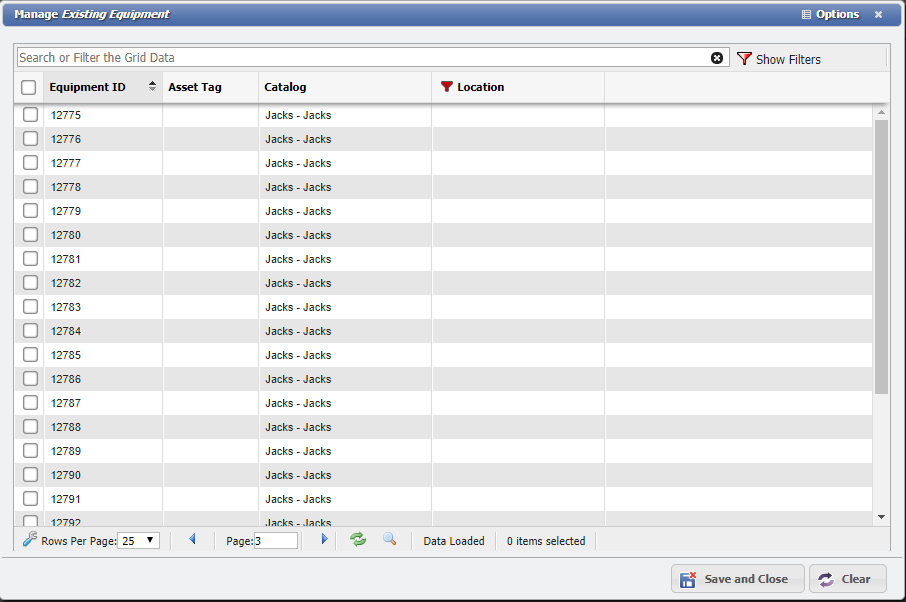
Manage Existing Equipment form example
Searching through this list and selecting multiple entries allows the User to add all the required Equipment entries. Check each of the Equipment entries that need to be associated with the Service and click save.
Deleting an Association
Selecting the

Cabling
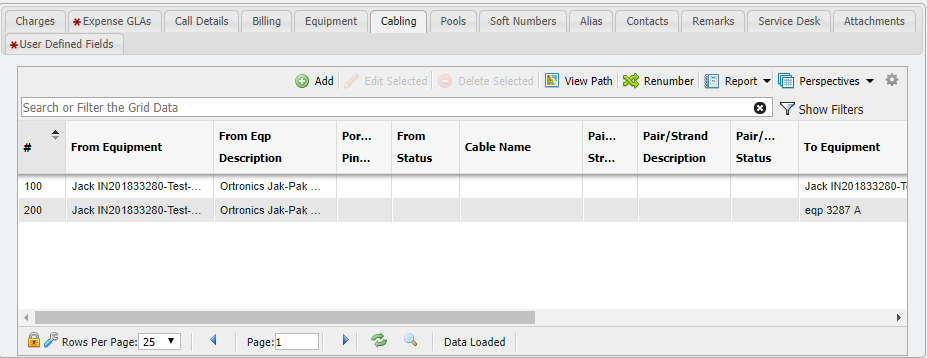
Cabling Tab Example
The Cabling tab allows Users to manually add, change, remove, and view Cable Paths. These Paths can also be built from Service Order Cabling on Service Desk.
Adding a Cable Path
To manually add a Cable Path to a Service, the User adds the Path Legs to the Cabling Grid. These legs form the Cable Path for each service. Once added to the Service, the Pairs/Strands and Ports/Pins/Len become Assigned.
Editing/Removing a Cable Path
To change a Cable Path for a Service, the User can edit and assign new Path Legs to the Service into the Cabling Grid.
Viewing the Path
The

Pools
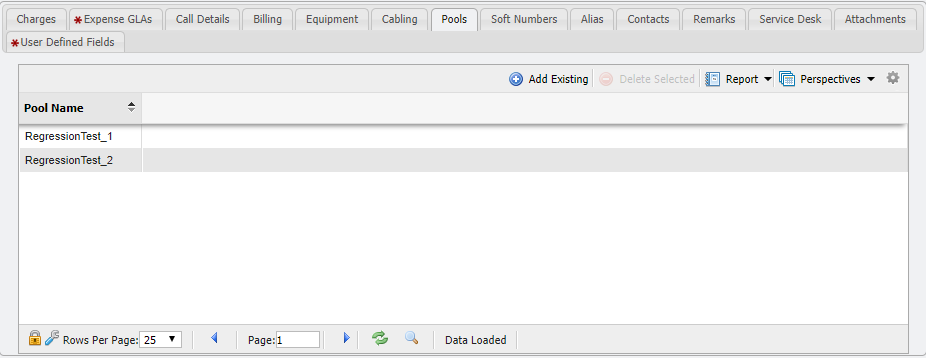
Pools Tab example
The Pools tab provides the User the ability to assign each service to a Service Pool. These Pools are a collection of phone numbers that are grouped with specific Service Catalog requirements. The list of Pools is managed by the Administrator from the Pools section of the application. Each Service must belong to one of the Catalogs or an ancestor Catalog specified on the specified Pool.
Soft Numbers
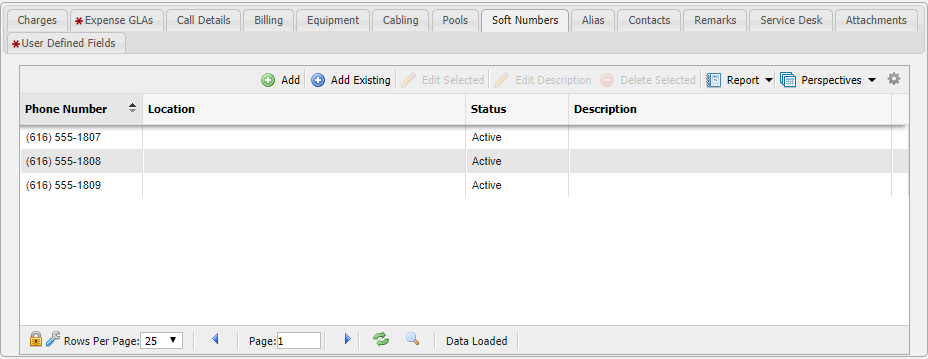
Soft Numbers Tab example
The Soft Numbers (sometimes called Line Appearance) tab is only available for Phone Services. Here, Users can choose to add an existing Phone Service as a Soft Number. Click the ![]() button located on the Grid Toolbar above the Soft Numbers Grid. Add a new Soft Number by clicking the
button located on the Grid Toolbar above the Soft Numbers Grid. Add a new Soft Number by clicking the ![]() button. For example, a department's numbers might appear on an administrative assistant's phone.
button. For example, a department's numbers might appear on an administrative assistant's phone.
While Users who select Add Existing are prompted to choose from a list of existing Active Phone Services, Users who select Add New are prompted to define a new Phone Service in its entirety. Because a Soft Number is a Phone Service in its own right, the Soft Number data entry form is virtually identical to the original Phone Service data entry form.
Alias
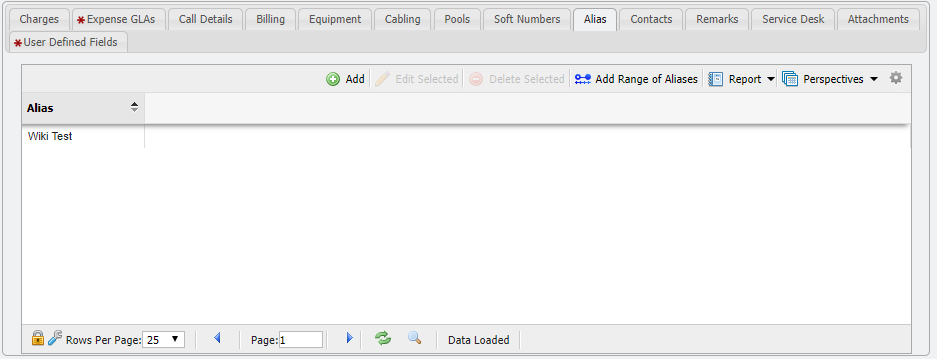
Alias Tab example
The Alias tab allows the User to create an Alias for this Service. The Alias replaces the Service ID (phone number) on any Rated Calls. This tab was created to give the User a method to process and Rate Calls from Phone Services that are not in the Main > Services > Phones table. The 360 Call Rating process first looks for the originating phone number from the call detail record (CDR) in the Phone Services table. If it’s not found, PCR-360 looks through the Aliases table. If the number is not in the Alias table, the Call’s Status is changed to "Error" and it’s saved until such time as PCR-360 knows the number for Billing. If the number does exist in the Alias table, the Call is processed but the originating number is changed from the Alias value to the number to which it is assigned. A Phone Service can have multiple Aliases.
This is done to hide potentially sensitive Service ID's on the Bill. This tab is only available for Phone Services.
Contacts
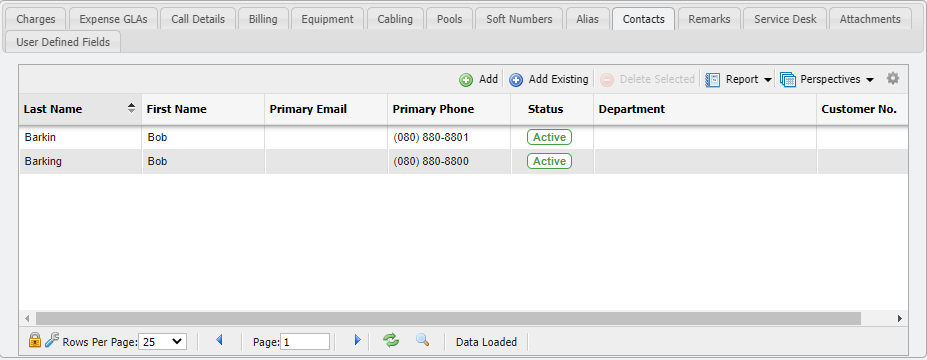
Service Contacts tab example
The Contacts tab provides the User the ability to manually associate Contacts with each Service. These associated Contacts represent people who may be associated with the Service in some way. These Contacts are separate entries in the Workers/Contacts section of the application that are associated with the Service for tracking purposes. This association can be built manually or via Service Order Contacts on Service Desk.
The User can manually manage these associations by using the Add, Add Existing, and Delete Selected functionality available on the Services Contacts tab.
Adding New Contacts
After clicking on the

Adding Existing Contacts
After clicking the

Deleting an Association
Selecting

Remarks
The Remarks tab provides the User the ability to add comments and Remarks to this Service. By default, a Remark cannot be edited or deleted once it is added.
Note: Remember that depending on the System Configuration Remarks may not be editable once added.
Add Remark
Remarks are useful for making notes about a Return Order that might need to be recalled in the future. To add a Remark, follow these steps:
Click the
button.
This will open the 'Add New Remark' form.
Enter the Remarks desired into the field.
Click the 'Save New'
button.
The Remark will be added to the list along with a User ID and time stamp for tracking.
View/Edit Remarks
Double-click or select the

The form will open so the User can read all the content of a given Remark.
Click the
UNKNOWN ATTACHMENT
button to commit any changes made to the Remark.
Delete Selected
Clicking the

Use of HTML Tags
Some fields within PCR-360 allow Users to input HTML tags to make displaying that information a richer experience for those that are expected to consume it. For more information on HTML tag usage, please see the wiki entry for it.
Adding Via 360 View
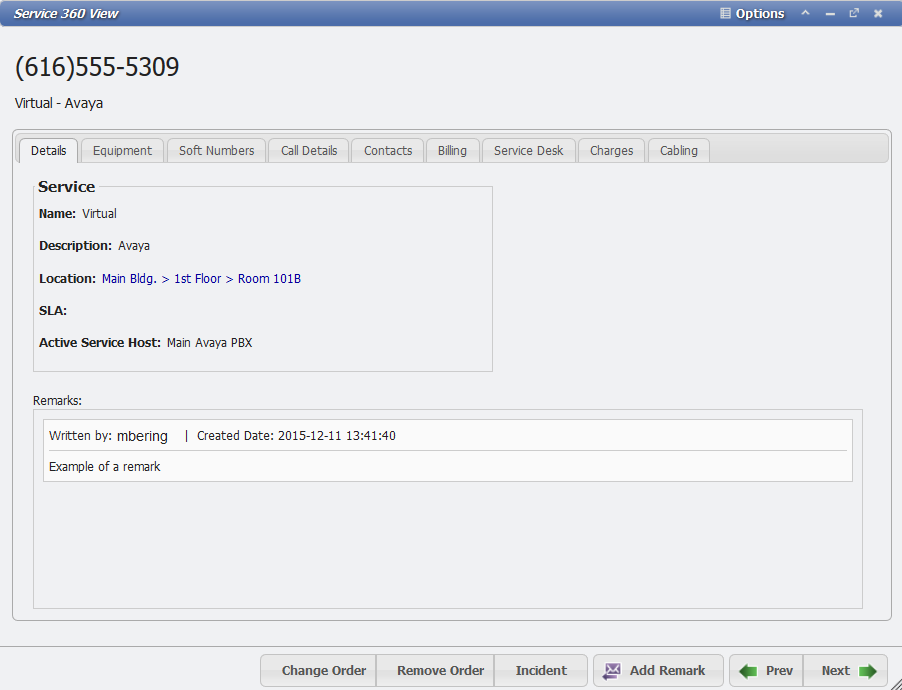
Service 360 View form example
An alternative way to add a 'Remark' is from the 360 Search. If a User selects a matching Service from the 360 search results, the Service 360 View form opens. At the bottom of this form, there are a series of buttons. Users can find the 360 View version of the

Aging a Remark
With Aging the general idea is that the data on the Service should be removed. This would include any Remarks. So the question of "What happens when a Phone Number is receiving harassing phone calls?" arises. Normally, an Administrator might add Remarks to the Service to explain why a number is set to Inactive. However, since the Aging process might remove the Remarks about the harassing calls, that data then gets lost.
So the real question here is how can an Administrator make it so that the Service is not reused after Aging to prevent the harassing calls from recurring for someone else?
The best way to handle this is to set the Service to a Service Pool with Services that are designated "Do Not Use". By adding the Service to this Pool, the Service will be designated to not be used simply by being in the "Do Not Use" Pool. Additionally, the Administrator can add a User Defined Field (UDF) that will persist through Aging as well, with the flag "Verify Field Data" set to call attention to UDF. Using the method provides a backstop to the need to not use the Service since a Remark could easily be overlooked when re-assigning the Service with an Add Action.
Service Desk
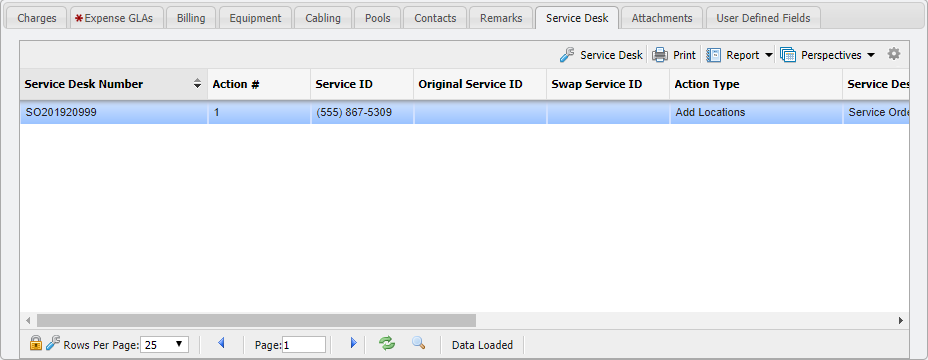
Service Service Desk Tab
The Service Desk tab provides a list of Service Desk Orders or Incidents that have been created for this Service. Incidents appear immediately when they are created, but Service Orders may not appear in this list until they are completed. Select the Service Desk option to open one of the associated Service Desk entries.
Archived Service Desk Items
When a related Service Desk Item to the Service becomes Archived, the

Attachments
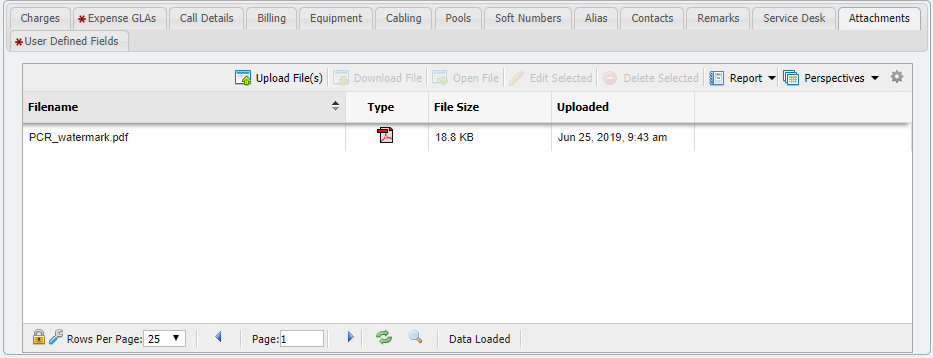
Attachments Tab example
The Attachments tab allows Users to attach files (including .pdf, .jpg, .doc...) of interest or relevance to the service by upload.
Uploading a File
To attach one or more files, navigate to the Attachments tab and click the Upload File(s) button located on the Grid toolbar above the Attachments Grid. The User is prompted to select the file(s) from their hard drive to upload. Upon selection of a file(s), the upload begins automatically.
Download File
Allows a User to download a file to their local machine. Useful to make modifications to a file which can then be re-uploaded.
Open File
This opens the file, if possible, for viewing by the User. No modifications of the original file can be made when opened in this manner.
Edit Selected
Allows the name of the file to be modified within PCR-360. If a User modifies the name of the file, that is the new name that is used when downloading the file.
Delete Selected
This removes the file from PCR-360.
Locations
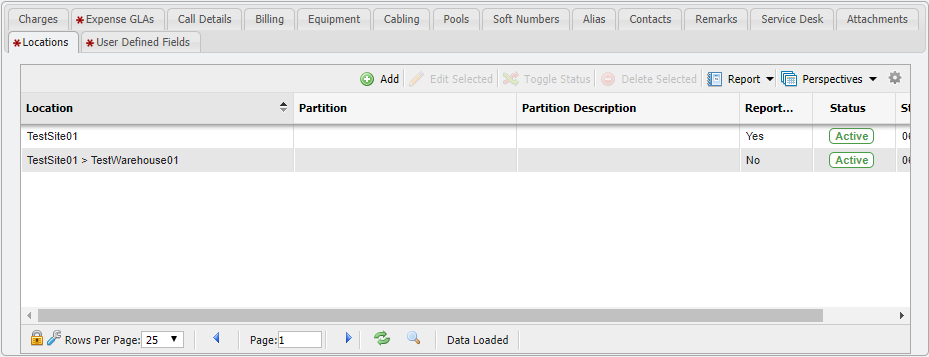
Locations Tab example

Add New Location form example
One tab that is unique to Phone Services is the 'Locations' tab. This tab only appears when the Multiple Locations flag is checked. This flag indicates that a Phone Service appears in multiple locations and disables the Location field on the main form. From the Locations tab, the User can manually edit all the locations that associated with this Phone Service. This can also be managed from Service Order - Add Locations in Service Desk.
User Defined Fields
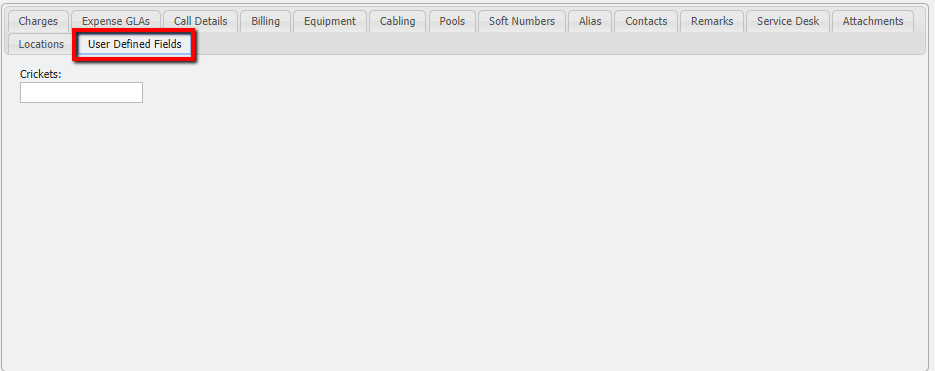
User Defined Fields Tab example
The User Defined Fields tab provides access to any extra fields that are defined for the Service Catalog specified on each Service. Any fields that are defined on for the Service appears on this tab.
See Adding User Defined Fields for more information.
